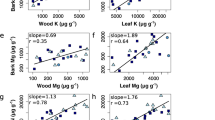Abstract
Aspen bark was investigated for photosynthetic function, pigment content, and spectral characteristics during the 1993–1994 Boreal Ecosystem-Atmosphere Study (BOREAS) summer field campaigns in the boreal zone of Saskatchewan, Canada. Parameters related to photosynthetic function were similar for bark and leaves: chlorophyll (Chl) concentration; fluorescence responses; and spectral reflectance. Similar increases along a vertical gradient from base to tree top were observed for incident photosynthetically active radiation (PAR), photosynthetic pigment content, photosynthetic capacity, and spectral reflectance variables. Since transmittance of aspen bark periderm was 20–30% in the blue, and 50–60% in the red Chl absorption bands, the PAR available to the photosynthetic cortical layer in the natural, canopy environment (<1000 μmol m−2 s−1) was sufficient to support positive net assimilation (<8–10 μmol CO2 m−2 s−1) under ideal conditions (e.g., light, temperature, saturating CO2), a rate approximately 30–50% that of leaves. However, the respiring tissues comprising the greater fraction of bark tissue bias the balance of CO2 exchange in favour of respiration for the whole bark. Therefore, net photosynthesis under ambient conditions on the whole bark was, in general, negative. The total bark surface area was estimated to contain 17–40% of the whole tree Chl. The contribution of the bark surface area fraction of the full canopy (leaves plus bark) increased with age (<60 years), with a similar trend expected for bark in total tree (and stand) photosynthesis. A spectral reflectance variable, the red edge inflection point (REIP), was related to total bark Chl content (r2 = 0.74). A better predictive relationship (r2 = 0.82) for total bark Chl was observed using a spectral index calculated from the reflectance ratio of two narrow wavebands (R3/R2: R2 and R3 are between 0.715–0.726 μm and 0.734–0.747 μm, respectively), which may have greater utility in landscape remote sensing. The bark spectra for Chlcontaining bark should improve understanding of carbon balance in aspen forests, based on landscape-level radiative transfer simulations.
Access this chapter
Tax calculation will be finalised at checkout
Purchases are for personal use only
Preview
Unable to display preview. Download preview PDF.
Similar content being viewed by others
References
Avery, T. E. and Burkhart, H. E.: 1983, Forest Measurements, 3rd ed., McGraw-Hill, New York, 331 pp. Brayman, A. and Schaedle, M.: 1982, Plant Physiol. 69, 911–915.
Brayon, O. V.: 1973, Fluorescent Microscopy of Plant Cells and Tissues. Kiev, Russia 142 pp. [In Ukrainian.] Covington, W. W.: 1975, Ecology 56, 715–720.
Forestry Canada: 1993, National Forestry Database. Can. Council For. Mins., Ottawa, Canada
Foote, K. C. and Schaedle, M.: 1978, For. Sci. 24, 569–573.
Goetz, S. J. and Prince, S. D.: 1995, Remote sensing of net primary production in boreal forest stands. Agric. For. Meteorol. (In press).
Gundersen, A.: 1954, Torrey Bot. Club B. 81, 210–214.
Hiscox, J. D. and Israelstam, G. F.: 1979, Can. J. Bot. 57 1332–1334
Johansen, D. A.: 1940, Plant Microtechnique, New York, USA, McGraw-Hill, 523 pp.
Kharouk, V. I. and Terskov, I. A.: 1982, Pigments in Tree Tissues,Nauka, Novosibirk, Russia, 88 pp. [In Russian.]
Middleton, É. M., Sullivan, J. H., Chan, S. S., Boyard, B., DeLuca, A. and Cannon, T.: 15 pp. (Unpublished manuscript.)
National Aeronautics and Space Administration (NASA): 1994, Boreal-Ecosystem Atmosphere Study (BOREAS) Experimental Plan, V. 3. 0 ( May), Goddard Space Flight Center, Greenbelt, MD, USA.
Pearson, L. C. and Lawrence, D. B.: 1958a, Amer. J. Bot. 45, 383–387.
Pearson, L. C. and Lawrence, D. B.: 1958b, Minn. Acad. Sci. 25–26, 101–107.
Perala, D. A.: 1990, In: Silvics of North America, Hardwoods. Washington D.C., USA, 2, pp. 555–569.
Rock, B. N., Hoshizaki, T. and Miller, J. R.: 1988, Rem. Sensing Environ. 24, 109–128.
Rock, B. N., Williams, D. L., Moss, D. M., Lauten, G. N. and Kim, M.: 1994, Rem. Sensing Environ. 47, 176–189.
Sanio, C.: 1860, Jahrb. Wiss. Bot. 2, 39–109.
Schaedle, M. and Brayman, A.: 1986, Tree Physiol. 1, 53–56.
Schaedle, M. and Foote, K. C.: 1971, For. Sci. 17, 308–313.
Scott, D. G.: 1907, Amer. Bot. 21, 327–439.
Sellers, P. J., Berry, J. A., Collatz, G. J., Field, C. B. and Hall, F. G.: 1992, Rem. Sensing. Environ. 42, 1–30.
Theisen, A. F. and Rock, B. N.: 1994, In: International Symposium on Spectral Sensing Research `94 (ISSSR), 10–15 July 1994, San Diego, USA, pp. 737–748.
Author information
Authors and Affiliations
Editor information
Editors and Affiliations
Rights and permissions
Copyright information
© 1995 Springer Science+Business Media Dordrecht
About this paper
Cite this paper
Kharouk, V.I., Middleton, E.M., Spencer, S.L., Rock, B.N., Williams, D.L. (1995). Aspen Bark Photosynthesis and Its Significance to Remote Sensing and Carbon Budget Estimates in the Boreal Ecosystem. In: Apps, M.J., Price, D.T., Wisniewski, J. (eds) Boreal Forests and Global Change. Springer, Dordrecht. https://doi.org/10.1007/978-94-017-0942-2_46
Download citation
DOI: https://doi.org/10.1007/978-94-017-0942-2_46
Publisher Name: Springer, Dordrecht
Print ISBN: 978-90-481-4605-5
Online ISBN: 978-94-017-0942-2
eBook Packages: Springer Book Archive




